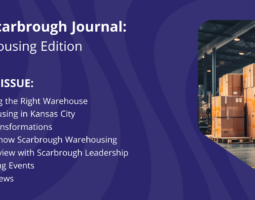5 Ways SFP is Better for Amazon Fulfillment than FBA
Offload Amazon fulfillment with a Fulfilled by Amazon (FBA) plan? Or hire a 3PL to process your Prime orders with a Seller Fulfilled Prime (SFP) strategy? Online sellers wrestle with the question every day.
We spoke with Scarbrough Warehousing’s resident Amazon fulfillment expert and Senior Manager of Warehouse Operations Mark Harding to get some insight. His answer? Choose SFP for better sales margins and more control over your fulfillment processes.
“There’s all these FBA consulting resources saying you don’t have to worry about anything — you just have to put up the capital for the inventory and get it to Amazon then sit back and collect a check,” Harding said. “The issue with that is no one ever tells you the margin of the check that FBA is going to end up taking.”
Harding argues that SFP’s lower storage costs, flexible services, and superior customer service all provide an edge over the more rigid offerings from FBA — all while taking advantage of Amazon Prime listings and visibility.
1. Storage Costs
For starters, it simply costs more to store inventory with FBA. According to Harding, storage costs for Amazon’s fulfillment program range from roughly $40 per pallet to $95 per pallet during peak holiday rush. By contrast, 3PLs typically charge as low as $20 or less per pallet with SFP models.
That cost difference can add up quickly.
“It’s a good way to save a good chunk of change on the margin of your product,” Harding said. “Your margins aren’t getting eaten up by storage costs nearly as quickly with SFP.”
2. Inventory Availability
To sell product in the first place, inventory itself needs to be properly processed and stored. Unfortunately, Amazon’s capacity restrictions often result in delayed inventory processing or outright inventory rejections.
Amazon has enacted capacity caps for all customers using the FBA model. That means many sellers are only able to keep approximately half their normal inventory stocked at Amazon distribution centers. Plus, according to Harding, Amazon has limited drop-off appointments.
“If you’re a larger seller delivering inventory multiple times a week, now you can only deliver twice a week or maybe even once a month,” he said.
Harding also pointed to long inventory processing times that Amazon customers have seen recently.
“Even if you can get around the storage constraints and get around inventory delivery constraints, there’s nothing that says Amazon will actually process that material and get it in stock,” Harding stated. “I’ve literally had people tell me they sent in their freight (to Amazon) and it sat in a trailer on the yard for weeks before they brought it in.”
“It just sits and accumulates cost.”
Using a 3PL to fulfill prime orders, on the other hand, isn’t likely to present the same issues.
“A 3PL wants you to bring in as much as possible – and inventory turn times can be as short as 48 hours from arrival at the dock to processed and in stock,” Harding said.
3. Shipping Flexibility and Reliability
You may not get the shipping reliability you want from FBA, either — especially with Prime orders.
Amazon has strict stipulations in place for Prime shipping. But Harding says Amazon itself will circumnavigate the rules to ship as cheaply as possible. Which may or may not stick to the two-day shipping protocol.
“The seller doesn’t receive any benefit from Amazon going around their own rules,” Harding said. “Then the seller potentially gets negative reviews because of Amazon’s operations and you’re still paying for Prime service.”
Part of that limitation comes from the fact that Amazon works almost exclusively with UPS for third-party shipping. Plus, UPS itself has placed pickup and capacity restrictions for Amazon. A 3PL has no such constraints, allowing SFP customers to access a broader spectrum of shipping options like FedEx,DHL, and USPS with more flexibility.
“It always makes sense to diversify your business and have a multitude of options for shipping. If needed, you can flip a switch and tomorrow change over from FBA to SFP, Harding said. “You can still use Amazon to sell your products but you don’t have to rely on them for fulfillment.”
4. Customer Service
It’s not just pricing and practice that give SFP an advantage over FBA — there’s a human element, too. Amazon’s size and automation make it difficult to get help from real people when you run into snags. Contact a 3PL for SFP help, however, and you’ll talk directly to a human for more direct assistance and quicker solutions.
“A 3PL is about selling a solution around customer service, not just peddling the platform as the selling tool,” Harding said. “You can call and talk to an actual person regarding your orders or the status of your account or the strategies of your account. By contrast, Amazon has a one-size fits all model.”
5. Customize Strategy with 3PL
While Amazon’s sheer scale can be an advantage in some regards, it can be a limiting factor for sellers who want personalized fulfillment solutions. Flexibility, customization, and agility aren’t typically found with the FBA platform. It’s a solution that’s designed to broadly serve thousands of customers with a plug-and-play strategy. According to Harding, developing a Prime fulfillment strategy with a 3PL allows for a more customized solution.
“Amazon doesn’t care what you’re selling – they have a set way of going to market and doing their fulfillment,” Harding said. “A 3PL is going to take the time to tailor a SFP strategy that works for your business’ specific needs.”
If you’re ready to move forward with a Seller Fulfilled Prime solution, Scarbrough Warehousing is ready to lend a hand. Amazon fulfillment experts like Mark Harding can help you make sound decisions about your SFP operation to help ensure timely, cost-effective delivery to customers. Contact us to get started.

